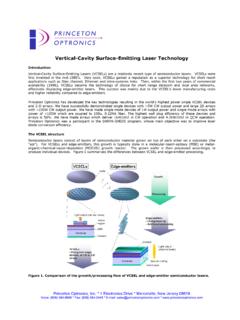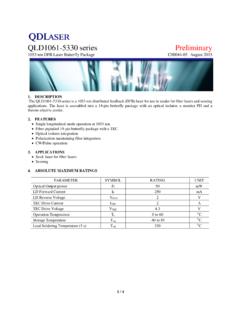Transcription of FIBER OPTIC SOURCES - ijsret
1 Shanti Institute of Technology, Meerut ( ) - 250501, India 109 International Journal of Scientific Research Engineering & Technology ( ijsret ) ISSN: 2278 0882 EATHD-2015 Conference Proceeding, 14-15 March, 2015 FIBER OPTIC SOURCES Beena Kashyap, Amit Kashyap M. Tech. (ECE), Shanti Institute of Technology, Meerut, India ABSTRACT The optical source is often considered to be the active component in an optical FIBER communication system. Its fundamental function is to convert electrical energy in the form of a current into optical energy (light) in an efficient manner which allows the light output to be effectively launched or coupled into the optical FIBER . Three main types of optical light source are available. (I) Wideband continuous spectra source (incandescent lamps); (II) Monochromatic incoherent SOURCES ( Light emitting diodes); (III) Monochromatic coherent SOURCES (LASERs).
2 Two basic light SOURCES are used for FIBER optics lasers and light-emitting diodes (LED). Each device has its own advantages and disadvantages 1. LASER 2. LEDs I. INTRODUCATION LASER = light amplification by stimulated emission of radiation Invented dated to 1958 with the publication of the scientific paper, Infrared and Optical Masers, by Arthur L. Schawlow, then a Bell Labs researcher, and Charles , a consultant to Bell Lab. Lasers work as a result of resonant effects. The output of a laser is a coherent electromagnetic field. In a coherent beam of electromagnetic energy, all the waves have the same frequency and phase. Light-emitting diodes (LEDs) are promising lighting SOURCES for general lighting applications with the promise of being more than ten times as efficient as incandescent lighting. Such characteristic combined with their long operating life and reliability has made them becoming a potential choice for next generation of lighting systems including automotive, emergency, backlight, indoor, and outdoor.
3 To ensure proper operation and to control the light intensity, LEDs need an efficient driver, normally implemented by power electronics-based conversion stages, to match the LED characteristics with the AC grid voltage and to generate a controllable, high quality light. Luminous flux is an attribute of visual perception in which. II. LASER The Word LASER is an acronym for light amplification by stimulated emission of radiation, which sums up the operation of an important optical and electronic device. The laser is a source of highly directional, monochromatic, coherent light. The optical source is often considered to be the active component in and optical FIBER communication systems. Laser beam have the many properties some property are given below: Monochromatic: consists of an extremely narrow range of wavelengths Directional: travel in a single direction within a narrow cone of divergence Coherence: coherence is the most fundamental property of laser light and distinguishes it from the light from the other SOURCES III.
4 BASIC CONCEPTS OF LASER Basic concepts are the basic principle which governs the operation of both these optical SOURCES . There are three types of processes involving the interaction of light beams with atoms that have electrons residing in various energy levels: (I) Absorption (II) Spontaneous Emission (III) Stimulated Emission (I) Absorption & emission of radiation:- Figure1: Absorption, Spontaneous Emission, Stimulated Emission Process Absorption illustrates a two energy state or level atomic system where an stom is initially in the lower energy state. When a photon with energy (E1-E2) is incident on the atom it may be excited the higher energy state through absorption of the photon. This process is known as Absorption process. Shanti Institute of Technology, Meerut ( ) - 250501, India 110 International Journal of Scientific Research Engineering & Technology ( ijsret ) ISSN: 2278 0882 EATHD-2015 Conference Proceeding, 14-15 March, 2015 (II) Spontaneous Emission:- By spontancons emission in which the atom returns to the lower energy state in an entirely random manner.
5 This process shown by the Sponantaneous emission. (III) Stimulated Emission:- By Stimulated emission when a photon having an energy equal to the energy difference between the two states interacts with the atom in the upper energy state causing it to return to the lower state with the creation of a second photon. This process shown by the Fig. 1 Stimulated Emission Population inversion process:- Figure: 2 Population inversion process Under the conditions of thermal equilibrium given by the Boltzmann distribution the lower energy level E1 of the two level atomic systems contains more atoms than the upper energy E2. This situation, which is normal for structures at room temperature,is illustrated in fig.. However, to achieve optical amplification it is necessary ton create a nonequilibrium distribution of atoms such that the population of the upper energy level is greater than that of the lower energy level.
6 This condition, which is known as population inversion, is illustrated in Fig. TYPES OF LASER Gas Lasers Chemical lasers Dye lasers Metal-vapor lasers Solid-state lasers Semiconductor lasers IV. LEDs A P-N junction diode that emits light when connected in forward bias junction is termed as LED. The emitted light may be visible or invisible and the amount of radiated light output is directly proportional to forward current. A light emitted diode (LED) is a semiconductor diode that emits incoherent narrow spectrum light when electrically biased in the forward direction of the p-n junction. This effect is a form of electroluminescence. An LED is usually a small area source, often with extra optics added to the chip that shapes its radiation pattern. The colour of the emitted light depends on the composition and condition of the semiconducting material used and can be infrared, visible, or near ultraviolet.
7 Semiconductor materials can be classified as: Direct bandgap materials Indirect bandgap materials Figure3: LEDs LED OPERATION:- A light emitting diode (LED) is a type of semiconductor diode that emits light when a current flows from anode to cathode across the PN junction of the device. When the LED is forward biased the electrons in the n-region recombines cross the P-N junction and recombine with the holes in P region free electrons resides in the conduction band while the holes in the valance band. When the recombination takes place the recombining electrons releases energy in the form of light as the materials are direct band gap semiconductor material now these electrons return back to valance band which is at lower energy level than the conduction band .Returning back the recombination electron give away the excess energy in the form of light. LED CONSTRUCTION:- LED is the one type of PN junction diode.
8 LED has the one junction and two layer. The construction of LED is not similar to a normal signal diode. LED consists of a PN junction surrounded by a hard, transparent plastic epoxy resin hemispherical shaped body. It protects the LED from shock and vibration. The LED junction does not emit much light, so the construction of epoxy resin body helps in reflecting away the emitted photons of light from the surrounding substrate base, thus focusing upwards through the top. However, some LEDs have cylindrical or rectangular shape construction with a flat top or surface. The cathode and anode terminal of an LED is normally identified by a notch. Shanti Institute of Technology, Meerut ( ) - 250501, India 111 International Journal of Scientific Research Engineering & Technology ( ijsret ) ISSN: 2278 0882 EATHD-2015 Conference Proceeding, 14-15 March, 2015 A cross sectional view of a typically diffused LED is given The semiconductor material used is gallium arsenide (GaAs), gallium arsenide phosphate (GaAsP) or gallium phosphate (GaP).
9 An N type epitaxial layer is grown upon a substrate and the P region is required to be kept at the top. Thus the P region becomes the device surface. The metal anode connections are made at the outer edges of P layer so as to allow more surface area for the light to come out. A gold film is applied to the substrate bottom to reflect as much as possible of the light toward the surface of the device and to provide a cathode connection. LED is manufactured with domed lenses so as to reduce the re-absorption problem. LED is always encased in order to protect their delicate wires. LED made from GaAs emit invisible infrared light, LED constructed of GsAsP tend either red or yellow light. The GaP LEDs give either red or green light. Figure4: Led Construction LED CIRCUIT SYMBOL:- Fig. 5 shows the circuit symbol for a LED. The arrows are shown as pointing away from the diode indicating that light is being emitted by the device when forward biased.
10 Figure: 5 LED Circuit Symbol LED CHARACTERISTICS:- Figure6: LED Characteristics Fig. 6 shows the forward bias V-I curve for a typical LED employed in burglar alarms. Forward bias of approximately one volt is required to give significant forward current. also shown provides radiant power forward current curve. The radiant output power is rather small and indicates a very low efficiency of electrical to radiant energy conversion Fig. 7 shows a source connected to series resistor Rs and a LED. The outward arrows symbolize the radiated light. The forward resistance of LEDs is very low which means that once the forward bias exceeds, the current through it will increase rapidly for only a very small increase in voltage. Thus it becomes necessary to use an external series current limiting resistor. The value of series resistor Rs can be determined from the following equation.













